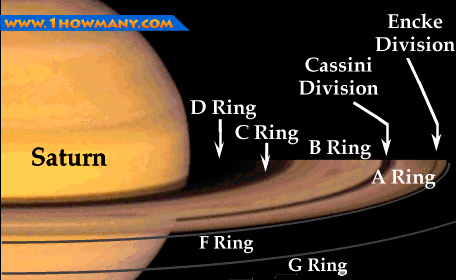www.1howmany.com
Example How Many Rings Does Saturn Have
Science / How Many Rings Does Saturn Have
How Many Rings Does Saturn Have
General Facts about Saturn
The name of Saturn is of Roman origin. In the religion of ancient Romans Saturnus was the major god who was in charge of agriculture and harvest. He is supposed to be equal to such gods from other myths as Cronus, Ninurta, and Shani. One of the days of the week, Saturday, is named after this planet.
Saturn stands the sixth from the Sun and is situated between Uranus and Jupiter. In the whole Solar System1 there is only one planet larger than Saturn. It is Jupiter. Saturn, Jupiter, Neptune and Uranus are gas planets, and together they are called the Jovian.
Saturn’s radius is about nine times larger than the one that the Earth has. But it spins on its axis very quick. That is why its year is more than twenty nine Earth years long, but its day has no more than ten and a half hours.
Saturn Rings
As stated above, Saturn has a distinctive feature, which it is widely known for. Of course, we are talking about its ring system.
Though people discovered Saturn thousands years ago, they had not been able to see its rings because it is impossible without a telescope. In 1610, Galileo observed the rings but thought them to be Saturn’s two moons. Dutch astronomer Christian Huygens had a more advanced telescope than Galileo, so in 1655 he was able to scrutinize the planet thoroughly and espied the rings.
In fact, these rings are not solid. They are made of separate parts. As they reflect about 80% of the light, there is every reason for thinking that they are chunks of ice, though gravel, dust, rocks, and similar objects can also be among them. All these particles orbit the planet individually. Their size can vary from less than one millimeter to about twenty meters. It is interesting that every ring has its own atmosphere, separate from Saturn’s atmosphere.
How Many Rings Does Saturn Have?
The question about the exact number of Saturn rings is rather difficult, but scientists have been able to give answer to it. Latin letters are used to classify the main rings. Here are their short descriptions.
- Ring A is very bright and outer-lying. It has its moon named Daphnis orbiting inside it.
- Ring B is the largest and densest of all Saturn rings.
- Ring C is very faint.
- Ring D is located closest to Saturn and is hard to see.
- Ring E is a very wide and outer-lying ring made of ice chunks.
- Ring F has the unique spiral strand around it. It is the farthest ring from Saturn.
- Ring G is situated between rings F and E. It is small and hardly visible.
- Ring O was discovered in 2010. Now it is supposed to be the largest ring.
As you can see, now we can talk about eight Saturn rings. But there is also the Phoebe ring, which was also discovered not long time ago. This ring has got a backwards orbit and is tilted a bit.
But the above mentioned objects are not the only Saturn rings, because this planet has also some divisions and gaps in them. The most widely-known of them are the Cassini Division2, the Janus Ring, the Anthe Ring Arc, the Methone Ring Arc, the Pallene Ring, and the Roche Division. So if we take into account all of them, we will get more than thirty rings.

- The Solar System is the system which contains the Sun and eight planets (Mercury, Earth, Venus, Mars, Saturn, Jupiter, Neptune, Uranus, and Pluto) with their moons orbiting round it. The Solar System also contains asteroids, comets, and meteoroids.
- The Cassini Division is a wide gap between Saturn Ring A and Ring B, discovered by Giovanni Cassini in 1675.
You may be interested in:
Comments
